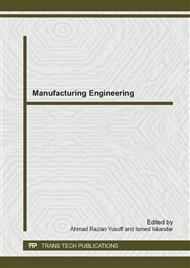[1]
T.D. Klastorin, Project Management, Tools and Trade-offs, John Wiley and Sons, New York, (2004).
Google Scholar
[2]
P. E. Josephson, and L. Saukkoriipi, Slöseri ibyggprojekt: Behov av förändrat synsätt, Fou-Väst, Report 0507, Gothenburg, Sweden, (2005).
Google Scholar
[3]
J. K. Lee, Cost Overrun and Cause in Korean Social Overhead Capital Projects, Roads, Rails, Airports and Ports, Journal of Urban Planning and Development. 134(2008) 59-62.
DOI: 10.1061/(asce)0733-9488(2008)134:2(59)
Google Scholar
[4]
D. Aloini, R. Dulmin, Risk Management in ERP Project Introduction: Review of the Literature, Journal of Information and Management . 44(2007) 547-567.
DOI: 10.1016/j.im.2007.05.004
Google Scholar
[5]
G. Themistocleous and S. H. Wearne, Project Management Topic Coverage in journals, International Journal of Project Management. 18(2000) 7-11.
DOI: 10.1016/s0263-7863(99)00030-7
Google Scholar
[6]
J.H. M Tah and V. Carr, Knowledge-Based Approach to Construction Project Risk Management, Journal of Computing and Civil Engineering. 15 (2001) 170-177.
DOI: 10.1061/(asce)0887-3801(2001)15:3(170)
Google Scholar
[7]
T. Lyons, , and M. Skitmore, Project Risk Management in the Queensland Engineering Construction Industry: A Survey. International Journal of Project Management. 22(2004) 51-61.
DOI: 10.1016/s0263-7863(03)00005-x
Google Scholar
[8]
A. Datta, S. Mukherjee and V. Kumar, Buffer Management in Real-Time: Architectures and Techniques, K-Y Lam and T-W Kuo ( Eds), Kluwer Academic Publishers, 2001, pp.77-95.
Google Scholar
[9]
M. Meyer, Managing Project Uncertainty: From Variation to Chaos, INSEAD, Singapore, (2000).
Google Scholar
[10]
T. Kaplan and P. Garrick , On the Quantitative Definition of Risk, Journal of Society for Risk Analysis. 1(1991) 11-37.
Google Scholar
[11]
J. Puente, R. Pino, P. Priore and D. Fuente, A Decision Support System for Applying Failure Mode and Effects Analysis, International Journal of Quality and Reliability Management. 19 (2002) 137-150.
DOI: 10.1108/02656710210413480
Google Scholar
[12]
A. Pillay, and J. Wang, Modified Failure Mode and Effects Analysis using Approximate Reasoning, Journal of Reliability Engineering and System Safety. 79 (2003) 69–85.
DOI: 10.1016/s0951-8320(02)00179-5
Google Scholar
[13]
I. Motawa, , C. Anumba and A. El-Hamalawi, A Fuzzy System for Evaluating the Risk of Change in Construction Industry, Journal of Advances in Engineering Software. 37(2006) 583-591.
DOI: 10.1016/j.advengsoft.2006.01.006
Google Scholar
[14]
M. Abdelgawad and A. R. Fayek, A Comprehensive Hybrid Framework for Risk Analysis in the Construction Industry using Combined FMEA, Fault Trees, Event Trees, and Fuzzy Logic, Journal of Construction Engineering Management. 138(5) 642-651.
DOI: 10.1061/(asce)co.1943-7862.0000471
Google Scholar
[15]
M. Park and F. Pena-Mora, Reliability Buffering for Construction Projects, Journal of Construction Engineering and Management. 130(2004) 626-638.
DOI: 10.1061/(asce)0733-9364(2004)130:5(626)
Google Scholar
[16]
I. Oya Tukel, An Investigation of Buffer Sizing Techniques in Critical Chain Scheduling, European Journal of Operational Research. 172(2006) 401–416.
DOI: 10.1016/j.ejor.2004.10.019
Google Scholar
[17]
H. Kerzner, Project Management, A System Approach to Planning, Scheduling and Controlling, Eight ed., John Wiley and Sons, New Jersey, (2003).
Google Scholar
[18]
W.S. Herroelen and R. Leus, On the Merits and Pitfalls of Critical Chain Scheduling, Journal of Operations Management. 19(2001) 559–577.
DOI: 10.1016/s0272-6963(01)00054-7
Google Scholar


